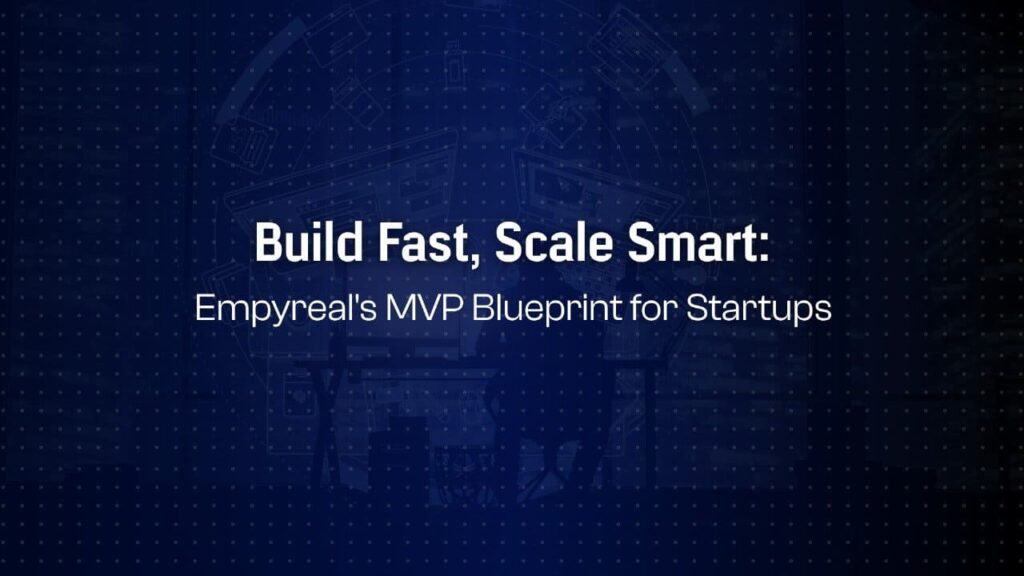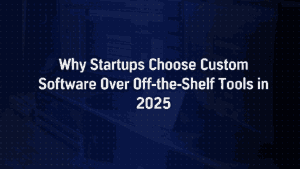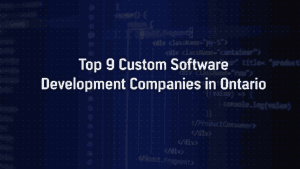Build Fast but Build Smart: Empyreal’s MVP to Scale Blueprint for Custom Apps
Building a startup means moving quickly and wisely. Founders must launch a working product to test their vision, yet avoid short-sighted shortcuts that block future growth. Empyreal’s blueprint is all about balancing speed with strategy. It shows how to quickly go from idea to Minimum Viable Product (MVP), then methodically scale that MVP into a full-fledged custom app. This guide walks founders through each step from wireframing your concept to defining API logic, deploying efficiently, and iterating based on real user feedback so you build fast but build smart. Along the way, we draw on industry best practices and examples (e.g., Foursquare’s famously stripped-down first release) to illustrate how a lean, iterative approach saves time, money, and headaches down the line.
Understand the MVP Mindset
A Minimum Viable Product (MVP) is the bare-bones version of your app that still delivers core value. The lean startup principle teaches that by launching an MVP you validate your idea with real users before over-investing in features. As one guide notes, launching with just a handful of well-researched features is safer than going all-out, counterintuitive though it seems. In practice, almost half of built features never get used, so leaving non-essentials for later saves huge time and effort.
For example, Foursquare’s original 1999 MVP let users only “check in” at locations and earn badges, nothing more. That minimal app still hooked early users and collected valuable data, setting the stage for later growth. In general, a streamlined MVP helps founders confirm product-market fit without wasting resources. It also attracts early adopters and investors: a quick-to-market prototype can build momentum and show funders a working idea. According to UrLaunched, launching fast with fewer features not only saves up-front cost, but also gives you something to show customers and investors immediately.
Empyreal’s approach starts here: define the problem your app solves, and focus only on must-have features. Avoid feature creep. As one expert advises, “speed to market is the all-important KPI for an MVP any feature that’s not a must-have should go back to the board.” Founders should refine the idea through market research and user interviews before writing a line of code. Use tools like landing pages, ads, or simple prototypes to gauge interest and collect email sign-ups. This validation stage ensures you’re building what users actually want, not what you think they want. In short:
Defining Core Value and Prioritization
? Define your core value: Identify the single most important problem your app solves. What’s the “Aha!” feature that users must have? If uncertain, conduct quick surveys or interviews to confirm demand.
? Prioritize ruthlessly: Classify features as Must-Have, Should-Have, Could-Have, or Won’t-Have (for now). Many teams use the MoSCoW method, focusing only on “must” features for the MVP. Extras can wait for later releases.
Validation and Learning
? Validate with data: Even a simple mockup or landing page can test assumptions. Track click-throughs or waiting list sign-ups to see if people care. Remember: about 42% of apps fail due to lack of market need, so confirm demand early.
? Learn from examples: Study early versions of successful apps. Foursquare’s MVP, for instance, offered just badge check-ins, yet proved the concept. Like Empyreal, think lean: build the minimal testable product, then iterate.
By embracing the MVP mindset, Empyreal ensures you build fast to learn fast, while still preparing to scale later. The next step is translating that lean vision into concrete designs
Wireframing & Prototyping: Map the Core
With your core features nailed down, it’s time to visualize your MVP’s user journey before writing code. Sketch out basic wireframes and mockups that show the main screens and flows. These don’t need to be pixel-perfect, they just help everyone see the app’s skeleton. As one expert puts it: “build a basic wireframe for the product. It doesn’t have to be flawless, just functional enough for teammates and designers to visualize the features.” Essentially, wireframing is about clarity: it ensures you know exactly what screens you’ll build and how users will navigate them.
Wireframing sessions whether on whiteboards or tools like Figma or Miro align your team on the MVP’s scope. Work with designers, developers, and stakeholders to draw each screen: login, dashboards, feature pages, etc. Focus on the user’s path (e.g., how a user signs up, uses a feature, then logs out). A quick prototype (even clickable in Figma or a no-code app builder) can reveal gaps in flow before coding begins. In fact, Empyreal’s blueprint recommends treating prototypes as “precursors” to the final app: a sketch or simple interactive demo that collects early feedback.
Key Steps in Wireframing and Prototyping
For founders, this means:
? Sketch core screens: Use flowcharts or storyboards to map out user tasks (e.g., onboarding, main functionality). Even a paper sketch or Balsamiq mockup works. Keep it lean only show “must-have” elements.
? Use prototyping tools: Consider quick visual tools (Figma, Sketch, Adobe XD) or low-code platforms. For example, Retool is a drag-and-drop builder ideal for MVPs. You can assemble a working interface in days, connecting it to test data or simple APIs. If budget is tight, some founders even use generic form builders or clickable wireframes to simulate the experience.
? Iterate on feedback: Show the wireframe/prototype to a few target users or advisors. Look for confusion or missing steps. Adjust screens early much cheaper now than after coding. Remember: an MVP design only needs to cover core flows. Over-engineering the UI too early can waste time. As one CTO notes, “overengineering an MVP can do more harm than thinly written code that gets results.”
The goal is to leave wireframing with a crystal-clear MVP blueprint. You should know exactly which screens to build and how features connect, with no unanswered questions. This “map” speeds up the next phase: coding. By locking down the user experience first, Empyreal’s blueprint ensures development focuses on what matters most, not chasing visual bells and whistles.
Building the Backbone: API & Technical Architecture
With the product vision and designs in hand, it’s time to build smart. Empyreal advocates an API-first, modular approach for the backend. In practice, that means defining your API endpoints and data models before writing business logic. An API-first approach acts like a contract: frontend developers can start building against the API spec while backend engineers implement it. This parallel workflow slashes dev time.
Key Best Practices in Technical Architecture
Key best practices in this phase include:
? Document the API contract early: Decide on resource names, HTTP methods, and data schemas up front. Use tools like OpenAPI or Swagger to draft the contract. For example, if your app has users and tasks, you might define endpoints like /api/v1/users or /api/v1/tasks with standard GET/POST/PUT/DELETE semantics. This clarity avoids confusion later. A well-designed API “acts like a clear contract” between parts of the system.
? Adopt RESTful conventions and versioning: Use intuitive, resource-based URLs and consistent response formats. Plan for versioning (e.g., /v1/ in your paths) so you can update the API without breaking existing clients. In practice, choose one versioning strategy (URL path vs. header) and stick to it. This discipline lets you evolve the API over time, a hallmark of building smart.
? Leverage existing services (speed hack): Don’t reinvent the wheel for common features. Empyreal’s blueprint suggests integrating proven third-party APIs for authentication, payments, storage, etc. For instance, use Auth0 or Firebase Auth for secure login, Stripe for payments, or AWS S3 for file storage. These pre-built APIs can cut development time dramatically. A modern stack might involve mixing your custom API with SaaS components (e.g., a chat SDK, email service, or analytics). By standing on giants’ shoulders, you get reliability and save months of work. As Netguru puts it, “using pre-built APIs for authentication, payment processing, or data storage can significantly cut down development time.”
? Architect for scale from the start: Even if your first user count is small, pick an architecture that can grow. Empyreal’s playbook prefers a microservices or modular design. Break your app into distinct services (e.g., user-service, payment-service, notification-service) so each can be developed and scaled independently. Microservices are proven to “allow teams to innovate faster” and isolate failures. For example, if email notifications get heavy traffic, scale that service without impacting user logins. This decoupling also permits smaller deployment units and more flexible updates.
? Containerize and orchestrate: Package each service in a container (e.g., Docker). Then use a container orchestrator (like Kubernetes, AWS ECS / EKS) to manage deployments. AWS notes that orchestration tools “automate tasks like distributing containers, monitoring their health, and dynamically scaling them based on traffic.” This means you can push updates rapidly (rolling deployments, blue-green, etc.) and scale components up or down automatically. In short, containers + orchestrator let Empyreal set up a professional deployment pipeline early on.
? Choose the right data store: As your product grows, use managed databases designed for scale. If you need relational features, pick a cloud SQL service (e.g., Amazon RDS or Google Cloud SQL). For flexible schemas or massive scale, use a NoSQL database like DynamoDB or Firestore. The key is “right tool for the right job” don’t jam everything into a single legacy database. Empyreal’s blueprint favors cloud-managed data stores because they simplify scaling (you often get auto-sharding, read replicas, and pay-as-you-go throughput).
? Build core modules early: Certain features are essential even in an MVP. For example, user authentication must work flawlessly. If logins or sign-ups break, testers will abandon the app. Likewise, even if your MVP is free, implement a payment or billing stub so you’re ready for paid pilots. Vadim Kravcenko’s startup guide emphasizes shipping User Management and Payment/Subscription modules early. That way, you test end-to-end flows and avoid surprises later.
Throughout development, maintain high code quality: write unit/integration tests, enforce code reviews, and commit often to version control. In fact, Empyreal’s blueprint pairs perfectly with a DevOps mindset: Continuous Integration/Deployment (CI/CD) should be running by Day 1. As industry experts note, a CI process that merges all changes to a main branch and runs automated tests “allows teams to catch issues at early stages” and keeps the codebase stable. In practice, set up a CI pipeline (GitHub Actions, GitLab CI, Jenkins, etc.) that builds and tests every commit. This not only prevents runaway bugs, but also means you can deploy to staging or production with confidence whenever needed.
By following these technical best practices, you build smart: your MVP code is lean, testable, and ready to scale. With the architecture and APIs in place, the next step is getting your app into users’ hands through smooth deployment.
Deployment Strategy: Automate & Scale Infrastructure
Getting your MVP online quickly is critical. Founders often sweat deployment details, but Empyreal’s blueprint advocates automation and cloud-native methods to make this painless. The core idea is to deploy fast, iterate often, and not sweat the servers.
Key Deployment Recommendations
Key recommendations:
? Use CI/CD for deployment: Once you have version control and tests, connect them to a CI/CD service (e.g., GitHub Actions, CircleCI, GitLab, or a DevOps platform). With this in place, any push to main/master triggers automated building, testing, and (if all tests pass) deployment to a staging or production environment. Intertec reports that CI/CD pipelines “significantly reduce time to market” by automating testing and release processes. In practice, set up a pipeline that includes stages like: install dependencies, run tests, build artifacts (Docker images, web bundles), and deploy to a server or cloud. This way, your team can “move faster, validate MVPs, and iterate confidently” knowing that builds won’t break hidden issues.
? Choose a cloud platform: Deploy on a scalable cloud provider (AWS, Azure, GCP, or a platform-as-a service like Heroku or Vercel). The cloud abstracts away hardware so you can scale up instantly when needed. AWS notes that modernizing on cloud allows you to “scale applications quickly without the constraints of traditional, on-premise systems.” For an MVP, simplicity often wins: start on a PaaS or container platform that handles load balancing and basic scaling. For instance, deploying Docker containers on AWS Elastic Beanstalk, Google App Engine, or Kubernetes can give you strong defaults.
? Container orchestration: If you use microservices, run each service in its own container. Then use an orchestrator like Kubernetes (EKS / GKE), Docker Swarm, or ECS. Orchestrators automate deployments and scalability: e.g., they spin up more containers when traffic rises, and kill extras when it falls. This is crucial once you start scaling: it means Empyreal’s blueprint is already using professional-grade Ops from MVP. Even if Kubernetes seems heavy at first, managed solutions like AWS ECS or DigitalOcean Kubernetes can spin up an environment in minutes.
? Serverless for select features: For some tasks, you might skip servers entirely. AWS Lambda, Azure Functions, or Google Cloud Functions let you run code on-demand. This can be handy for background jobs (image processing, notifications) or even entire APIs. Empyreal often suggests evaluating serverless for parts of the MVP, because functions automatically scale and you only pay per execution. For example, you could implement your API endpoints as serverless functions triggered by HTTP requests. This offloads scalability concerns to the cloud provider, though it may complicate local development. Use serverless where it fits your stack and skillset.
? Database provisioning: Set up your database(s) in the cloud too. Use managed services (AWS RDS, Cloud SQL, Azure SQL, or NoSQL services like DynamoDB). This saves you from setting up and scaling database servers manually. For example, if using PostgreSQL, spin up an RDS instance; it will handle backups and multi-AZ replication automatically. As AWS advises, managed data stores eliminate operational complexity and let you “scale to accommodate fluctuations” with minimal downtime.
? Monitoring and logging: Even at MVP stage, include basic monitoring. Services like AWS CloudWatch, Datadog, or Papertrail can capture logs and metrics. At minimum, track whether servers are up and if any deployments fail. This ties into CI/CD so you get alerts on issues. It’s much easier to catch a database error or high CPU spike early than after hundreds of users.
By automating builds and infrastructure, Empyreal’s blueprint ensures deployment doesn’t become a bottleneck. Instead of manual server setup, your team focuses on code and users. When updates are ready, you simply push code and let the pipeline handle the rest. This means new features, bug fixes, and tweaks reach users fast, critical feedback comes sooner.
Iteration & Growth: Feedback Loops and Metrics
Launching the MVP is not the finish line, it’s the starting gun for continuous improvement. Empyreal’s “build fast but build smart” philosophy extends to post-launch: every day after launch should use real data to refine the product. This follows the Lean Startup build-measure-learn cycle.
Practical Steps for Iteration and Growth
In practical terms:
? Collect user feedback and data: Integrate analytics (e.g., Google Analytics, Mixpanel) and track key metrics from the first day. What are your early users actually doing? Where do they drop off? Also solicit direct feedback: use surveys, interviews, or simple NPS polls. The metrics matter too keep an eye on things like churn rate (how many users stop using the app), monthly recurring revenue (MRR) if you have subscriptions, ARPU (average revenue per user), customer acquisition cost (CAC), and LTV (lifetime value). Empyreal stresses making data-driven decisions. For example, if a feature isn’t being used (or user drop-off is high during signup), investigate and iterate.
? Analyze and prioritize improvements: Use the data to drive your next steps. Which features do users love, and which do they ignore? As research shows, roughly 45% of built features go unused, so cut the dead weight. Often the next version of the app will involve refining the MVP’s core based on this feedback. Follow-up analysis, such as funnel tracking or cohort analysis, can pinpoint leaks in the user experience.
? Lean Startup cycle: After each release, decide quickly whether to pivot or persevere. Empyreal’s guide recommends asking: “What does the data tell us?” If a hypothesis is confirmed (e.g., users love a particular function), double down and expand it. If not, be prepared to pivot maybe by adjusting the feature set, targeting a different user segment, or tweaking the business model. Pivoting isn’t failure; it’s a strategic reorientation based on learning. As the Lean Startup guru Eric Ries advises, startups should be built to test hypotheses rapidly. In practice, that means doing small, fast releases (sprints or release cycles each week or bi-weekly) and measuring impact immediately.
? Iterative development: Use agile practices. Each iteration (sprint) should produce a working increment that can be shown to users. Include the team in reviewing analytics: discuss what’s working (keep those features) and what’s not (either improve or drop those). Keep your backlog lean only promising ideas get built. Empyreal’s formula is to “iterate and pivot as needed until you find a successful business model.” In each cycle, refer back to your MVP vision and user stories.
? Pivot smartly: If the core idea needs change, do it. Being agile enough to pivot is “not a setback but a strategic move.” For example, maybe users only care about a subset of features; consider refocusing on that. Because you built a flexible MVP (perhaps even starting with a no-code version), you should be able to pivot without huge cost. Keep communication clear with users: tell them about updates or changes so you maintain trust.
Throughout this phase, keep refining both product and process. Automate more tests, add new monitoring alerts for post-launch issues, and iterate on your development pipeline as needed. Each iteration should “circularly” improve the app and its technical foundation. Over time, gradual improvements accumulate into a mature, robust system.
Empyreal’s blueprint emphasizes one more thing in the iteration phase: monitor operational metrics too. Even as you chase user feedback, watch performance. Track server response times and error rates in your API. Netguru’s best practices recommend logging API metrics so you can identify bottlenecks as you scale. For instance, if an endpoint suddenly slows under load, you can optimize it before users complain. This kind of proactive maintenance, part of “building smart,” makes scaling smoother when growth hits.
Key Takeaways for Founders
Empyreal’s MVP-to-Scale blueprint boils down to a few core principles. By following these, you’ll balance rapid progress with a solid foundation:
? Start Small, Think Big: Launch an MVP quickly by focusing on must-have features. Use wireframes and prototypes to validate the concept before coding. This minimizes wasted work.
? Prioritize Ruthlessly: Employ methods like MoSCoW to include only critical functionality in the MVP. Remember that nearly half of features often see no use, so resist the urge to add “nice-to-haves” too early.
? Design & Prototype: Map out user flows and screen mockups. A simple design is fine, perfection can come later. A clear prototype uncovers UX issues before code is written.
? Modular Architecture: Build an API-first, modular backend. Define clear APIs and version them. Use microservices or decoupled components so you can scale parts independently. Leverage existing services (auth, payments) to save time.
? Automate Deployment: Set up CI/CD pipelines immediately. Deploy on cloud or PaaS with container orchestration. Automating build/test/deploy ensures reliability and lets you push updates frequently.
? Measure & Iterate: After launch, rigorously track usage and feedback. Improve what works, fix what breaks, and be ready to pivot if needed. Make each release smaller and data-driven.
Throughout, the mindset is: fast feedback beats guesswork. By building a lean MVP (fast) and planning a scalable architecture (smart), Empyreal’s blueprint helps founders validate their product quickly while avoiding technical debt. The result is a custom app that not only launches sooner, but grows smoothly into the future.




